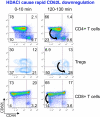Histone/protein deacetylases and T-cell immune responses
- PMID: 22246031
- PMCID: PMC3311271
- DOI: 10.1182/blood-2011-10-292003
Histone/protein deacetylases and T-cell immune responses
Abstract
Clinical and experimental studies show that inhibition of histone/protein deacetylases (HDAC) can have important anti-neoplastic effects through cytotoxic and proapoptotic mechanisms. There are also increasing data from nononcologic settings that HDAC inhibitors (HDACi) can exhibit useful anti-inflammatory effects in vitro and in vivo, unrelated to cytotoxicity or apoptosis. These effects can be cell-, tissue-, or context-dependent and can involve modulation of specific inflammatory signaling pathways as well as epigenetic mechanisms. We review recent advances in the understanding of how HDACi alter immune and inflammatory processes, with a particular focus on the effects of HDACi on T-cell biology, including the activation and functions of conventional T cells and the unique T-cell subset, composed of Foxp3(+) T-regulatory cells. Although studies are still needed to tease out details of the various biologic roles of individual HDAC isoforms and their corresponding selective inhibitors, the anti-inflammatory effects of HDACi are already promising and may lead to new therapeutic avenues in transplantation and autoimmune diseases.
Figures



References
-
- Allan SE, Broady R, Gregori S, et al. CD4+ T-regulatory cells: toward therapy for human diseases. Immunol Rev. 2008;223:391–421. - PubMed
-
- Koenen HJ, Smeets RL, Vink PM, van Rijssen E, Boots AM, Joosten I. Human CD25highFoxp3pos regulatory T cells differentiate into IL-17-producing cells. Blood. 2008;112(6):2340–2352. - PubMed
-
- Duarte JH, Zelenay S, Bergman ML, Martins AC, Demengeot J. Natural Treg cells spontaneously differentiate into pathogenic helper cells in lymphopenic conditions. Eur J Immunol. 2009;39(4):948–955. - PubMed
Publication types
MeSH terms
Substances
Grants and funding
LinkOut - more resources
Full Text Sources
Other Literature Sources
Medical

